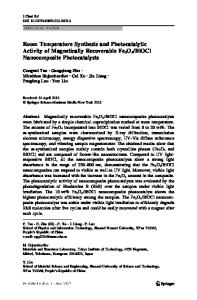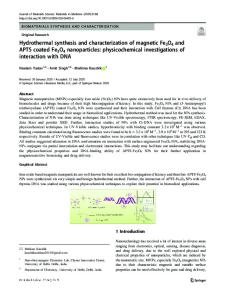Novel rattle-type magnetic Fe 3 O 4 @Ag@H-BiOCl photocatalyst with enhanced visible light-driven photocatalytic activity
- PDF / 1,774,296 Bytes
- 10 Pages / 595.276 x 790.866 pts Page_size
- 41 Downloads / 369 Views
Novel rattle-type magnetic Fe3O4@Ag@H-BiOCl photocatalyst with enhanced visible light-driven photocatalytic activity Jianhui Shi1 · Shuting Feng1 · Tian Chen1 · Fan Wu1 · Wenbo Guo1 · Yuzhen Li1 · Peiting Zhao1 Received: 15 March 2018 / Accepted: 6 April 2018 © Springer Science+Business Media, LLC, part of Springer Nature 2018
Abstract A novel rattle-type magnetic Fe3O4@Ag@H-BiOCl nanocomposite was prepared successfully by a facile solvothermal method. The structures, morphologies, magnetic and electronic properties and photocatalytic performance of as-prepared products were successfully characterized by multiple techniques. The results show that the composites exhibit an obvious cavity, excellent magnetic properties, largely increased electron–hole separation efficiency and visible-light absorption. Due to the existence of an inner cavity, this novel photocatalyst exhibits excellent adsorption and transfer performance to organic pollutants in aqueous systems. The photocatalytic activity of the materials was evaluated by the photocatalytic degradation of rhodamine B (RhB) and antibiotic agent ciprofloxacin (CIP). It was found that the Fe3O4@Ag@H-BiOCl exhibited much better photocatalytic performance than pure BiOCl, which displayed the degradation rates of RhB and CIP were 99.5 and 98.3% after 120 min under visible light irradiation, respectively. The enhanced photocatalytic activities may result from the synergetic promoting effect of surface plasmon resonance of Ag and facet-dependent oxygen vacancy of BiOCl, which significantly improves visible-light absorption capacity and separation rate of charge carriers. A possible mechanism of the enhancement of visible photocatalytic activity was proposed. This study provides a promising approach to improve visiblelight-response and recycle photocatalysts to treat waste water.
1 Introduction In the course of economic development, a series of problems on environmental pollution emerged, which have prevented the sustainable development of modern human society [1, 2]. The semiconductor-based photocatalytic technique, utilizing the renewable solar energy to mineralise organic pollutants into non-toxic products, is an effective method for degradating most types of environmental contaminants [3, 4]. Therefore, exploiting the novel and high-efficient hybrid photocatalysts is significant for air purification and waste water decontamination [5]. Among various semiconductor photocatalysts, bismuth oxyhalides are being investigated in details in recent years owing to their superior properties and practical applications. Due to the favourable visiblelight response of the bismuth oxyhalides, these photocatalysts have been studied by plenty of researchers in varying * Jianhui Shi [email protected] 1
College of Environmental Science and Engineering, Taiyuan University of Technology, Taiyuan, People’s Republic of China
degrees [6, 7]. However, as a semiconductor with a large band gap, the absorption capacity of a pure bismuth oxyhalide to visible-light is very limited towa
Data Loading...











